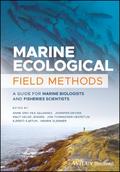Marine Ecological Field Methods
A Guide for Marine Biologists and Fisheries Scientists

1. Edition January 2018
240 Pages, Hardcover
Practical Approach Book
A comprehensive, clear, and detailed guide to procedures for conducting marine ecological field studies
Marine Ecological Field Methods is a comprehensive resource that offers the most relevant sampling methodologies for quantitative and qualitative studies of mesopelagic, demersal, littoral, and soft-bottom organisms, as well as relevant physical parameters. The authors describe how various sampling gears work, how to operate them, their limitations, guides on sorting and measuring collected organisms, and how to deal with subsamples of large catches. The text also explains how to use acoustic equipment for monitoring aggregations of organisms, for example fish shoals, as well as the use of sensors for registering environmental variables such as salinity, temperature, oxygen, and light.
The text contains cutting-edge research techniques that are in their final stages of development for use in research surveys. Marine Ecological Field Methods is designed to help with the entire procedure for conducting a field study, including the generation of hypotheses, planning field collection of data, conducting field work, data exploration and statistical analysis with the use of R, and presentation of results in a final report. This essential resource:
* Covers a wide range of techniques and methods for the marine environment
* Includes tried and trusted methodologies and techniques from a team of noted experts in the field
* Contains information on sampling equipment ranging from those that are useful in the littoral zone to shallow nearshore areas, including bottles, secchi discs, and gillnets, and finally large trawls, benthic sleds, ROV and advanced technologies for remote sensing in the open ocean.
* Explores the step-by-step procedures for conducting a field study, from formulating hypotheses to the process of registering and reporting results
Written for students and professionals in the field, this vital resource describes marine ecological sampling equipment, methods and analysis, ranging from physical parameters to fish, microalgae, zooplankton, benthos and macroalgae.
Chapter 1: The studied habitats
1.1. The coastal biotopes
1.2. The littoral habitat
1.3. The pelagic habitat
1.4. The soft bottom habitat
1.5. The light environment
Chapter 2: Methods/Sampling
2.1. Diary
2.2. Littoral survey design
2.3. Sampling the benthic zone
* 2.4. Introduction to sampling for marine molecular studies
2.5. Sampling the pelagic
*2.5.1 Introduction to acoustics and interpretation of marine data
2.5.1. Acoustic tracking of Diurnal Vertical Migrating organisms
2.5.2. Environmental variables
2.5.2.1. Measuring light
2.4.2.1. Conductivity, Salinity, Temperature, Oxygen
2.5.3. Plankton
2.5.4. Trawling
* 2.5.5. Deep Vision as a tool to identify, quantify and measure species inside a trawl
*2.5.6. Angling gear experiments
2.5.7. Preserving and labelling samples for storage
2.5.8. Recording data onto forms
2.5.9. From data sheets to data files
Chapter 3: Data analysis
3.1. Setting your work directory
3.2. Importing data
3.3. Working with data
3.4. Data exploration and statistical testing
3.4.1. Zooplankton samples
3.4.2. Following echo layer
3.4.3. Depth distribution at species level
3.4.4. Size distribution from pelagic trawls
3.4.5. Bottom trawls
3.4.6. Environmental data
3.5. Data analysis Littoral zone
3.5.1. Biological data
3.5.2. Performing the littoral data analysis using R
Chapter 4: Reference list
Chapter 5: Appendices
A1. Template for field reports
A2. Field data sets & supplementary R-functions for complex analysis: available online
A3. List of some useful R-codes and what they do
A4. Organisms present (100-200 pictures) most common in selected climatic zones
*Sections planned to be written
Index
ANNE GRO VEA SALVANES, JENNIFER DEVINE, KNUT HELGE JENSEN, JON THOMASSEN HESTETUN, KJERSTI SJØTUN, and HENRIK GLENNER, University of Bergen, Norway


